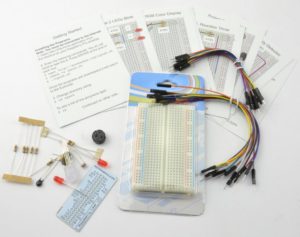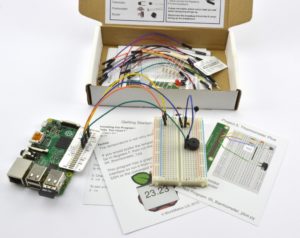Description
This kit is compatible with the Raspberry Pi models A, B, B+, 2, 3 and Pi Zero (header pins required for Pi Zero).

You are the proud owner of a Raspberry Pi and you are ready to start using it to experiment with electronics but where do you start?
The Raspberry Pi Electronic Starter Kit contains all the components you need, together with easy to follow instruction cards, in order to complete 10 simple experiments involving LEDs, thermistors, photoresistors and switches and is an ideal starting point for anyone new to electronics and the Raspberry Pi.
Contents
- 470Ω resistor (5)
- 1kΩ resistor (2)
- 4.7MΩ resistor (1)
- Red LED (2)
- RGB LED (1)
- Switch (2)
- 330nF capacitor (1)
- thermistor (1)
- photoresistor (1)
- buzzer (1)
- raspberry leaf (1)
- breadboard (1)
- male to male jumper leads (10)
- male to female jumper leads (10)
- 10 easy to use instruction cards
DOES NOT INCLUDE RASPBERRY PI
Projects
- Make an LED blink
- Make 2 LEDs blink
- RGB Colour Display
- Thermometer
- Thermometer Plus
- Reaction Timer
- Light Meter
- Light Harp
- Proximity Detector
- Email Notifier
This is the thermometer project. It uses a thermistor to measure the temperature and the program for it has a graphical display of the temperature. The buzzer at the bottom sounds when the temperature is higher than a set point.

Getting Started
1. Open up the box and find the first card called ‘Getting Started’. This will tell you how to download the programs that accompany the book. If you are curious, you can also see them here on Github.
2. Pick one of the ten project cards and use the breadboard layout diagram and component key on the box lid to assemble the design.
3. Fit the Raspberry Leaf GPIO template over the Raspberry Pi’s GPIO pins and connect the breadboard to the GPIO connector using male to female jumper wires.
4. Run the program for that project.
5. Open up the program in IDLE or a text editor and read the comments about how it works and tinker!
Resources
MonkMakes’ friend Henry Budden is working on some new projects for you to make using this kit. The first of these is a Sunrise Alarm Clock. You can download this for free from: Here.
The review from: https://www.monkmakes.com/rpi_esk/
Latest Instagram Posts
Error: Cannot retrieve posts for this hashtag.
The Hashtag "meloperoelectronics" requested by the user either cannot be seen due to missing permissions, is invalid or doesn't exist.


















Adam - October 18, 2019 @ 14:07
I bought this from “Almost Anything Ltd”. This unit failed within a few weeks and interestingly, it was only used once (to set up and install Raspian) then when tried again failed to show anything on the screen. I used to be a Java programmer and network administrator (on Novell networks) so yes I have exhausted all the avenues to resolve this and this unit is definitely duff. Yes most problems are software based despite people claiming it’s the hardware, but my unit was duff.
I bought this from “Almost Anything Ltd”. This unit failed within a few weeks and interestingly, it was only used once (to set up and install Raspian) then when tried again failed to show anything on the screen. I used to be a Java progra
Birdal - October 21, 2019 @ 19:20
My only regret is that I have not bought this earlier. As an Electronic Engineer, I can’t really comment on how easy is to use as the others might disagree. I have done quite a few projects and I’m really impressed with the quality. Is has never failed on me and it just works even though I have used it for continuous periods of time (in very long time-lapse photography). I am thinking to buy another one to have more projects in parallel. Definitely recommend and is a very good starting point for anyone that is interested in computers/electronics.
My only regret is that I have not bought this earlier. As an Electronic Engineer, I can’t really comment on how easy is to use as the others might disagree. I have done quite a few projects and I’m really impressed with the quality. Is ha
Chris - October 23, 2019 @ 05:22
Bought specifically to run Retropie (so I could relive my youth with perfect emulation of SNES, Megadrive, N64 etc), it’s a perfect emulation machine for under £35!
With WiFi, Bluetooth and full USB connectivity out of the box, I was playing Super Mario Kart with a pair of 8BitDo SN30 Pro pads within half an hour of opening the box.
It’s worth noting that the official Raspberry Pi PSU I bought with my Pi3 Model B isn’t powerful enough for this newer ‘B+’ model.
It’s only 2.5A output, were as the B+ needs a stable 3A or you get ‘under voltage’ alerts.
Bought specifically to run Retropie (so I could relive my youth with perfect emulation of SNES, Megadrive, N64 etc), it’s a perfect emulation machine for under £35!
With WiFi, Bluetooth and full USB connectivity out of the box, I was playing S
Mickey - October 24, 2019 @ 16:00
My Pi 3B+ works with a FlightAware ProStick Plus in my loft to feed a virtual radar aircraft display, and the system works better than the £400 Kinetic SBS-1 and £300 laptop it replaces, uses a lot less power, and is more reliable mainly due to the absence of Microsoft updates and regular USB dropouts from the flaky Windows USB system.
Quite why Amazon want me to give stars for “For beginners”, “Touch Screen” and “Remote Control” is beyond me, but then they clearly don’t have a clue what this is.
My Pi 3B+ works with a FlightAware ProStick Plus in my loft to feed a virtual radar aircraft display, and the system works better than the £400 Kinetic SBS-1 and £300 laptop it replaces, uses a lot less power, and is more reliable mainly due to the
Danie - October 25, 2019 @ 23:19
I stuck a 64GB uSD in it and loaded Raspbian. Now it works as my server for learning Linux server administration concepts. I have nginx on there for hosting a project i was making and tonight i installed Postgres on it which was good. Haven’t got any robotic projects in mind for it yet, but may do later on. If it broke, I’d buy another in a heart beat but now that the 4B is out it is probably worth getting that instead, despite the USB power issue.
I grew up on a Win 95 computer with 16MB of RAM or so, and a 4GB HDD. This SMB is more powerful than that old beasty, it’s incredible!
I stuck a 64GB uSD in it and loaded Raspbian. Now it works as my server for learning Linux server administration concepts. I have nginx on there for hosting a project i was making and tonight i installed Postgres on it which was good. Haven’t g
Grek - October 27, 2019 @ 18:18
The device is crazy cheap and has been doing a great job as a kiosk solution for us. Two have been running for over a year with only heat sinks installed. We only use Chromium browser on them so not very CPU demanding tasks although have tested some YouTube videos on it as well – not particularly fast but manages to display full HD (there was a couple of moments on the B version when it skipped – haven’t tested on B+ yet but in theory should be better with a 1.4Ghz vs. 1.2GHz CPU). The B+ fits the old original Pi case as per attached pictures. I have come across some power consumption information that indicate that this version has slightly increased and can draw 1.2AMP (6.5 Watt) so be aware of this.
The device is crazy cheap and has been doing a great job as a kiosk solution for us. Two have been running for over a year with only heat sinks installed. We only use Chromium browser on them so not very CPU demanding tasks although have tested some